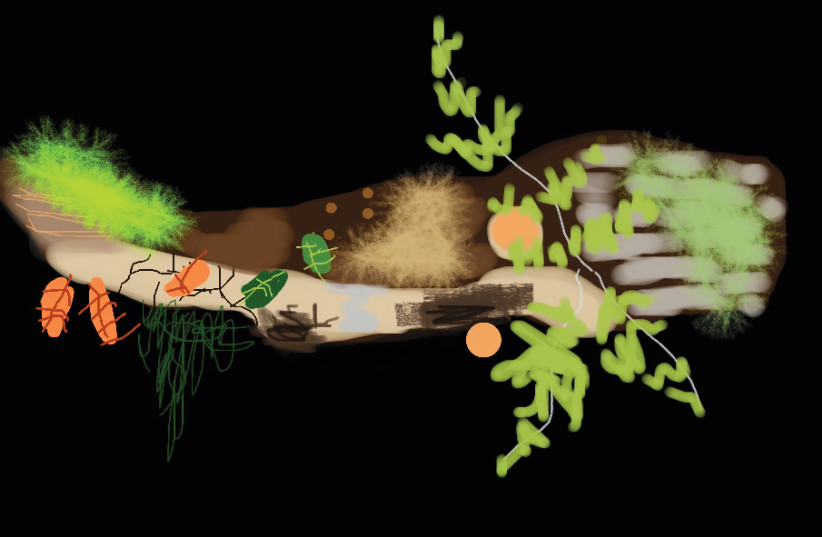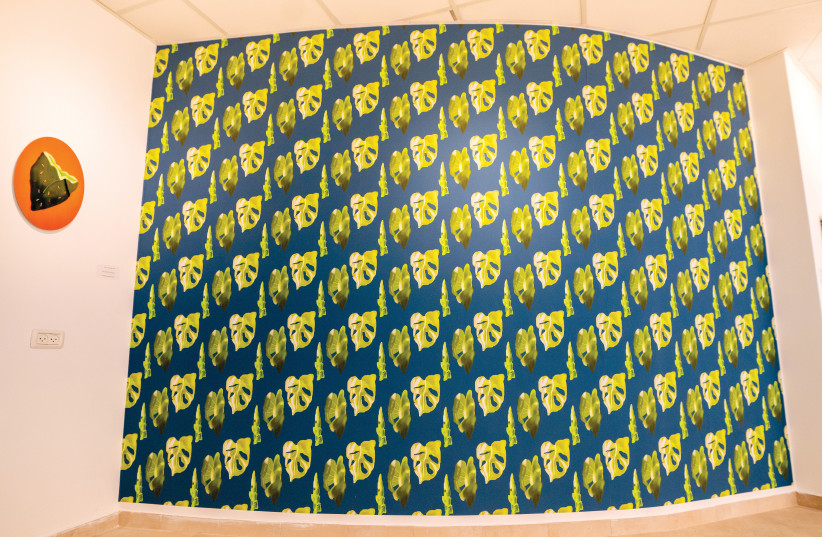If location, location, location is the mantra of any self-respecting real estate agent, the curatorial equivalent would probably be context, context, context. In that respect, Gaby Hamburg Fhima hit the jackpot when she took over the post of curator and art department honcho of the Jerusalem Botanical Gardens a few months back.
The curtain-raiser of the new gallery there is currently in progress, and visitors to the inaugural collection of works by Ayala Netzer will, no doubt, be well and truly in a suitable floral state of a mind by the time they make it up to the Yaar exhibition space.
As time progresses and – hopefully – that dark period of mass hospitalizations, mandatory masks and lockdowns fades into the far recesses of our memory banks, it is becoming increasingly clear that, while many of us had a hard time, there were benefits to be gleaned, too.
One of the most prominent positive side effects of the Health Ministry-imposed strictures is that while institutions remained closed to the public, they could consider all sorts of logistical ventures that, in the normal run of day-to-day operation, would not even make it to the suggestion box.
That goes for the Jerusalem Botanical Gardens, too.
“Hannah Rendell, who works in strategic development here [with the official title of executive director], came here from the YMCA. She comes from the art field, and immediately identified the potential [for arts-related activities].”
Gaby Hamburg Fhima
“Hannah Rendell, who works in strategic development here [with the official title of executive director], came here from the YMCA. She comes from the art field, and immediately identified the potential [for arts-related activities],” says Hamburg Fhima. “Then corona hit, and she started a process which resulted in the establishment of the art department here.” That, it should be noted, was enthusiastically encouraged by Gardens CEO Tom Amit.

Rendell was wily enough to know where to get a financial helping hand.
“Together with the [UK-based] Outset Contemporary Art Fund, which supports artists and curators, they initiated an exhibition called ‘Returning to Nature,’ of contemporary sculpture in open spaces,” notes Hamburg Fhima. “That was when everything was closed, but we had all these open spaces. We had this treasure of a place just waiting to be used. That was curated by Hadas Maor.”
That was followed by an augmented reality display, Seeing the Invisible, the result of another Rendell-Outset synergy, which is still on virtual view across the gardens’ grounds.
Now the Botanical Gardens’ artistic offerings have an indoor home of their own. And, while we’re on the subject of domiciles, and to borrow a little from verdant jargon, Hamburg Fhima has long and deep personal roots in her current place of employment.
“When I was six years old my grandparents made aliyah from Scotland, and moved into Nayot,” she explains. Nayot sits cheek by green jowl with the gardens. “This place was my backyard when I was kid, here and the Israel Museum.”
Not a bad for any youngster looking to get a health-inducing outdoor, floral, cultural head start on life.
“In many ways, this job is like a homecoming for me,” says Hamburg Fhima.
The art department head is keen for other children and their elders to get some of the didactic rewards she enjoyed so much in her earliest formative years, and which are on offer in abundance, outside and indoors. “Art should make us think and get us to ask questions. I think one of the roles of the Botanical Gardens is educational. I believe having art in the gardens serves an educational purpose. It is an additional means to teach people how to observe. In our case that relates to how to observe nature, but it is not just about looking at nature. It is also about how we view relationships between ourselves, and to be more circumspect about life around us.”
That quickly became core to the way Hamburg Fhima started getting to grips with her new job. “When I got here my official title was manager of the art department, but, right from the first day, I told the director that I want to change my job title. I feel that it shouldn’t be just about managing the art department. I believe there is a curator role to be filled here.” And so it was.
She certainly came with the requisite professional backdrop, having accrued a wealth of curatorial experience before she settled in at the Botanical Gardens. “I felt the place needed someone with a much broader viewpoint but, on the other hand, who also has the ability to collect and understand what happened here in the past and to tell the story to the outside world, so that it is clear that there is an art domain here.”
There certainly is now, and Hamburg Fhima wants us all to know about it. “I realized that I need to get the word out – to artists, curators, the public – that here we are reinstating or continuing some kind of process that was here before. We are founding something I called ‘Yaar [forest in Hebrew] – A Space for Art in the Jerusalem Botanical Gardens.’”
The aforementioned contextual element is a prime factor in the artistic domain, in the wider sense, in terms of humankind creative endeavor and what Mother Nature brings to the aesthetic table, albeit with quite a few artificial tweaks to ensure we get ourselves a plentiful variegated eyeful of flora and foliage.
“Under the title of Yaar you have all these things that are already here,” Hamburg Fhima continues. “I looked at all the sculpture here and studied the artists who created them. People come here and enjoy the sights, but there is no information about who created the works, and who donated them.” She believes apportioning credit where it is due. “If you went to the Sculpture Garden at the Israel Museum, for example, there is no possible way that information would not be there.” Point taken.
After showing me some of the natural alfresco beauty to be had at the gardens, including taking a delightful stroll across the elevated Treetops Bridge, we eventually get to the new exhibition facility.
HAMBURG FHIMA says she was duly inspired when she arrived, but also had her mettle well tested. “When I got to the conservatory I saw to the left there was a space which looked like my worst nightmare.” Mind you, she wasn’t about to reinvent the wheel. “I knew that my predecessor had put on an exhibition there, with works by people who volunteer in the gardens. But it had been something really esoteric. I said, this has to be a gallery. It’s not a classroom, it’s not a storeroom. It is a gallery inside the tropical conservatory.

“I don’t know if there is such a thing anywhere else in the world. There are art spaces, for example, at Kew Gardens [in London] and The Eden Project [in Cornwall, in southwest England], but I don’t think there is a gallery in a tropical conservatory.” Now there is, in good old Jerusalem.
The gallery generated some challenging labor pains for all concerned.
“I really went for it,” Hamburg Fhima chuckles. “I really stuck to my guns. I insisted on having suitable lighting installed. They cleaned up the ceiling and walls. The space filled with light.”
Indeed it did. That was patently obvious as I made my way into the exhibition area where a couple dozen or so Netzer creations were on display in entirely professional conditions.
The artist’s quote, on one of the walls, grabs you by the heartstrings and doesn’t let go. The plaintive observation states: “In the absence of any other motive, beauty is a reason to live.” As succinct philosophical declarations go, that is definitely up there with the best of them.
NETZER CLEARLY has a singular take on art forms and disciplinary approaches, and how to present them. She makes full use of contemporary technological means to convey the fruits of her artistic skills and talent to the public at large.
“She uploads one of her works to Facebook every single day,” Hamburg Fhima explains. “It is like a journal.”
For this exhibition the 36-year-old artist focused on flowers and foliage, taking images she captured with her cellphone camera before continuing the creative process by overlaying the photos with digital drawing software tools. That makes for a fascinating end product which seems to hover somewhere between photography and painting, with some X-ray elements stirred into the mix.
Some of the prints come with portentous musings. One, which seems to have an X-ray of a shin in the middle, bears the descriptive, somewhat dystopian quote: “Exhausted like a wooden log left outside for a future use that never comes.” Another references the artist’s emotional challenges and how she deals with the world around her. “Right now I’m not suffering” reads the emotive textual adjunct to a digital drawing print that shows a figure holding a large leaf that hides her entire face.
Another print, with a fetching, somewhat scraggly bunch of flowers protruding from a vase, comes with a far more upbeat message: “When the options are to wither or to change, I choose to grow.”
Even without the quotes, one gets a powerful sense of Netzer’s emotional state and her outlook on her life and the world. One particular poignant print shows a lush white flower, complete with golden stamen, growing out of a cactus. The artist makes do with the concise but elementally expressive title of “Perseverance.”
Hamburg Fhima has been conversant with Netzer’s oeuvre for some time, and says she knew it was only a matter of time before they would join forces. “When I arrived here and decided there would be a gallery, I knew she would be the first artist to exhibit here.”
She says Netzer was a natural choice on all sorts of fronts. “Ayala’s story is very moving, particularly in the context of educating towards art and observation and how, in fact, art becomes an educational tool for observation of our surroundings.
“Ayala has an autism spectrum disorder, which means she has a particular way of looking at things, and she operates on a very high level,” Hamburg Fhima adds. “She is incredibly gifted, but also expresses herself really well verbally. She is very intelligent, and we have riveting conversations.”
The exhibition also features an animation work, narrated by the artist.
“She talks about how art is her way of communicating with the world around her,” says Hamburg Fhima, referencing some of the complex dynamics Netzer sometimes experiences in her interpersonal relations. “People don’t know how to approach her, and then she creates something very beautiful, and then they come close. But then, frequently, they leave.”
There is a lot more to Netzer’s exhibits than initially meet the eye. “There is an oxymoronic mix here, between beauty and ugliness, pain and pleasure. All of that is deeply entrenched in her works,” Hamburg Fhima notes.
Naturally, the bucolic environs also came into play in the curatorial decisions and artistic choices.
“This talks about Ayala’s relationship with her surroundings, through nature. The metaphor she uses is nature.... She makes a connection between the organs of the vegetation and the way she sees, feels, yearns for those people who enter and leave her life.” ❖
The exhibition closes on August 19. For more information: www.botanic.co.il
